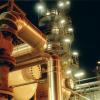Amitray,
You can refer to this same subject here: http://www.cheresour...culation-ratio/ .
The liquid to vapor ratio of 4 is equal to 20% of the mass fraction vaporized from the circulating flow in your thermysyphon reboiler. The figure 200 or 300 of recirculation ratio is equal to 0.5% or 0.33% or vapor fraction, but it may not be applicable to thermosyphon reboilers. I myself have rule-of-thumb value range of 5 % to 30% but usually takes values typically 10% to 15% for my design purposes. Much lower vapor fractions could be attainable for forced-circulation reboilers.
I understand there would not be "a critical value" or "critical range" of vapor fractions or recirculation raios in the reboiler design. Previous experience for the same or similar system could be a best guide. Organic materials are subject to be degraded if exposed at high temperatures then high circulation ratio with low vapor fraction shall be applied to minimize the contact time on the heating tube. Higher vapor rate at higher heat flux provide good driving force for the circulation. But higher vapor rate (lower circulation ratio) often makes 'film boiling" in the tube, which will substantially decrease overall heat transfer coefficient and bring unexpected severe fouling problems too. Based on an 'adequate' vapor fraction or recirculation ratio from the previous experience, two-phase hydraulic analysis shall be done properly for the circulation loop.
A general guide for typical heat fluxes can be used as a cross reference: file:///D:/%EB%B0%94%ED%83%95%20%ED%99%94%EB%A9%B4/%EA%B3%A4%EC%A4%84%EB%B0%95%EC%9D%B4/Understanding_Heat_Flux_Limitations_CCTI_2010.pdf
~Stefano

 FB
FB













